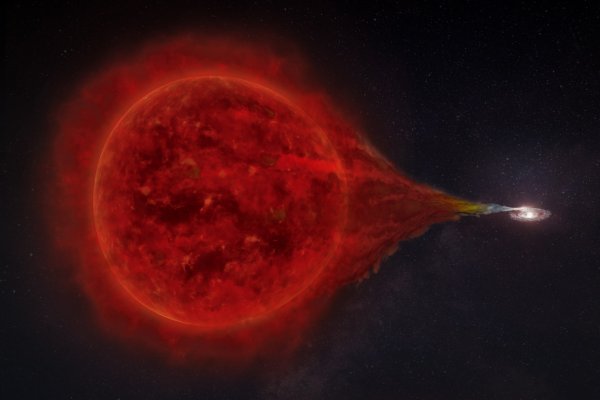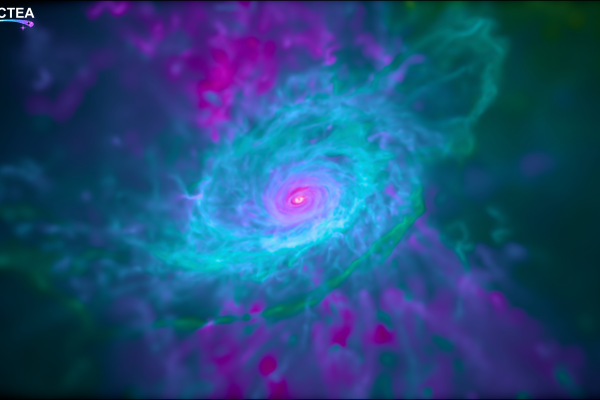A research team taking part in the MAGIC collaboration —international consortium including participation from experts of the University of Barcelona— detected very high-energy gamma rays from a recurrent nova in the Milky Way. The results of such observations and the new findings on these stellar explosions have been published in an article in the journal Nature Astronomy, signed by an international team which counts on the participation of the experts Josep Maria Paredes, Marc Ribó and Edgar Molina, from the Faculty of Physics, the Institute of Cosmos Sciences of the UB (ICCUB) and the Institute for Space Studies of Catalonia (IEEC).
The result of this study identifies these novae as a new type of source for very high-energy gamma rays. “This is the first episode detected at such energies and it allows us to better understand these eruptions and their potential role in the production of the mysterious cosmic rays that live in the Milky Way”, notes Professor Josep Maria Paredes, head of the Department of Quantum Physics and Astrophysics of the UB.
A new type of source of very high-energy gamma rays
The end of a star after its death depends on its mass. In about 5,000 million years, when the Sun runs out, it will expand into a red giant star, to end up collapsing into a stellar corpse known as white dwarf. These stellar remnants are dense and, under certain situations, they can produce large explosions. In binary systems where the white dwarf has a red giant star as a companion, the hydrogen from the most external layers of the red giant can succumb to the gravitational attraction of the white dwarf and accumulate on its surface.
This “vampirism” of a stellar corpse towards a star still in the active stage of its life results in a nuclear explosion in the surface of the white dwarf, “it causes it to expel most of the hydrogen and fusion products into interstellar space at speeds of between 2,000 and 4,000 kilometres per second”, says Marc Ribó, ICCUB researcher at the IEEC, vice-coordinator of physics at MAGIC and director of the Montsec Observatory.
This type of explosion is very luminous, it can be up to 100,000 times brighter than our Sun and it is known as a nova. “If the cycle of material transfer between both stars starts again, it can restart the process that will lead, in the future, to an explosion in the systems we know as recurrents”, notes Edgar Molina, also member of the ICCUB-IEEC team working in the collaboration of the MAGIC telescopes.
When the alert of the explosion of the RS Ophiuchi was received, on August 8, 2021, an extensive monitoring system was activated. “The eruption of RS Ophiuchi is a rare event in the gamma-ray sky: it is the most luminous nova and the one with the highest flux detected in gamma rays so far, and we just caught it on time”, says Rubén López-Coto, researcher at INFN Padova and IAA-CSIC of Granada, one of the main authors of the study. A series of observations followed, making this the first nova detected in a wide energy range, both from the Earth and space. On August 9, the MAGIC collaboration used its twin Cherenkov telescope array, located in the Observatory of Roque de los Muchachos, in La Palma island, to observe in the direction of RS Ophiuchi, from which it detected the source.
Thanks to the excellent observing conditions in La Palma, the fast reaction of the collaboration and the high sensitivity of MAGIC, the nova could be detected at energies 100 billion times higher than that of visible light. “This study identified novae as a new type of source of very high-energy gamma rays. Therefore, a new research line in the astronomy of very high-energy gamma rays has been opened”, adds Alicia López-Oramas, IAC researcher and one of the main authors of the study.
Novae, cosmic proton accelerators
Together with data at other wavelengths —including ground-based optical telescopes like the Joan Oró Telescope at the Montsec Observatory—, the research team could find a new fact: the explosion of the nova was energetic enough to produce strong shockwaves in the medium surrounding the stellar system. These shock waves are the ones accelerating the small subatomic particles present in the interstellar medium up to near-light speeds. Regarding the RS Ophiuchi nova, the model to describe best the observations from MAGIC and other telescopes confirms that the very high-energy gamma rays are produced by protons, positively charged particles that build up the nuclei of hydrogen atoms.
Although nova eruptions are less energetic than their cousins, the supernovas, in which a star dies in a catastrophic explosion, they are also more common. The obtained results by the group in the MAGIC collaboration show that, although most of the cosmic rays permeating the Milky Way are generated in other sources, novae can be surprisingly efficient at accelerating protons in their vicinity.
“Within MAGIC, we have been following up on nova explosions for quite some time already. It is always very gratifying when you see that the efforts pay off and we manage to open new windows that bring deeper knowledge of our Universe”, notes Óscar Blanch, spokesperson of the MAGIC collaboration. “It is the result of the work carried out by many people”, he concludes.
In order to fully understand the complicated association between violent events in the interstellar medium of the Milky Way, we need more observations like those in this article. The MAGIC collaboration will continue working on the celestial surveillance of stellar remnants in the Milky Way and in other galaxies.
The Magic Collaboration
The Spanish community takes part in the MAGIC since its start. Now, among the members of MAGIC are the Institute of Cosmos Sciences of the UB (ICCUB), the Research Centre for Energy, Environment and Technology (CIEMAT), the Canary Islands Institute of Astrophysics (IAC), the Institute of High Energy Physics (IFAE), the Autonomous University of Barcelona (UAB), the Complutense University of Madrid (UCM), and the Institute of Astrophysics of Andalusia (IAA). The Institute for Space Studies of Catalonia (IEEC) takes part in this project through the researchers of the ICCUB unit and the Centre for Space Studies and Research (CERES-UAB). Also, the MAGIC data centre is the Scientific Information Port (PIC), a collaboration between IFAE and CIEMAT.
Reference article:
MAGIC Collaboration et al. “Proton acceleration in thermonuclear nova explosions revealed by gamma rays”. Nature Astronomy, April, 2022. Doi: 10.1038/s41550-022-01640-z.
Further information:
Press Office
University of Barcelona
+34 934 035 544
premsa@ub.edu



